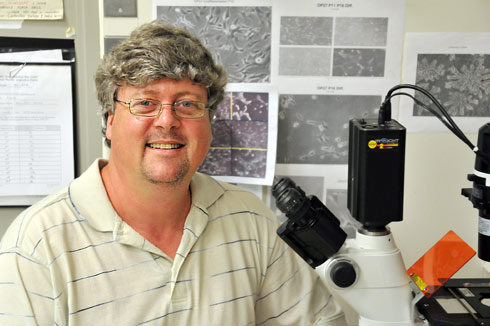NSF Supports Lane’s Research on Olfactory Receptor Gene Regulation

In order for animals to detect food sources, avoid predators and find mates, they rely on their olfactory system, or sense of smell.
The ability to detect and distinguish among thousands of environmental odorants is based on a combinatorial recognition system. A specific smell is coded in the brain by a specific combination of receptor proteins that get stimulated by the unique combination of odorant chemicals elicited by that scent.
“The smell of ‘lemons,’ for example, would result from a specific combination of odorant receptor proteins that become stimulated upon binding the specific set of inhaled chemicals emitted from a lemon,” explains Robert Lane, associate professor of molecular biology and biochemistry.
With support from the National Science Foundation (NSF), Lane will further investigate a complex odorant receptor gene regulatory system. His study, titled “Cross-Disciplinary Science & Investigation of Olfactory Receptor Gene Regulation” was funded with a two-year, $299,995 NSF grant through the American Recovery and Reinvestment Act of 2009.
NSF’s Recovery Act awards support researchers in institutions of higher education and other organizations throughout the nation. Lane’s grant was awarded in August.
In addition to investigating odorant receptor regulation, Lane’s work will potentially provide insights into the functional organization of genomes, as well as molecular mechanisms underlying gene co-regulation and cell differentiation.
The genome is the cardinal instrument of development that encodes the genetic parts and genetic programs of an organism.
“With the sequencing of many genomes now complete, and indeed, most if not all the genes identified, a next great frontier in the quest to understand the relationships between genotype and phenotype is to decipher how genetic information is regulated,” Lane explains.
Lane says the research will advance integrated approaches in science that foster broader modes of thinking and problem-solving.
“We’ll be exposing undergraduate and graduate students to a variety of fields, including evolutionary biology, genomics, bioinformatics, molecular biology, genetics and neuroscience,” he says.

